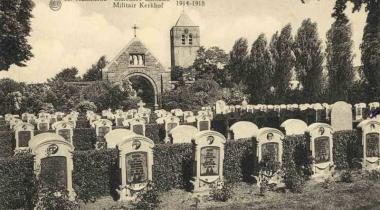-
History
The creation of the Cabour Hospital in Adinkerke in April 1915 and the L’Océan Hospital in De Panne in December 1915 leads to the inevitable establishment of a graveyard in their vicinity. Adinkerke cemetery hence is a typical example of a burial ground neighbouring a military medical installation. The first burials actually take place in mid-November 1914, but the venue is turned into a hospital cemetery when L’Océan is fully operational, with daily interments as a result. By the end of 1917 the grounds are filled to capacity, and after the opening of the military cemetery in De Panne, Adinkerke is only used sporadically anymore. By the end of the war 2,314 Belgian, 466 French and an unknown number of British soldiers are buried in Adinkerke. The many different tombstones and markings – some more durable than others – give the cemetery a rather disorderly appearance. The Ministry of Defence therefore takes control: uniform military headstones are introduced in 1924-1925.
The cemetery now contains 1,647 Belgian servicemen, some of whom lie under either personal headstones or heldenhuldezerken (a Flemish word designating a Celtic cross with a Flemish motto, placed by the Heldenhulde committee and created during the First World War by Flemish intellectual circles to honour fallen Flemish soldiers, as a substitute for the official marking “Mort pour la patrie” (Fallen for the nation) in French).
One Frenchman lies under a Belgian headstone, but with a French plaque. The 67 British rest under the familiar white headstones also found in British cemeteries. -
Casualties
1,647 Belgians First World War – 1 Frenchman First World War – 67 British First World War

Discription
The cemetery is situated behind the St. Audomar Church and the Adinkerke communal graveyard. The long rectangle extends over some 2.5 acres. The surrounding buildings prevent the extension required in 1917. A central path runs to the rear of the cemetery. It is initially planted with shrubs, but these have gradually made way for the present-day red gravel. The graves are largely arranged in double rows. White roses bloom between the tombstones. The cemetery is accessed through an arcade with wrought-iron gates.
